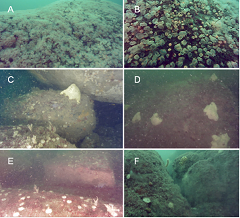Identifying vulnerable marine ecosystems from imagery in the Uruguayan continental shelf
DOI:
https://doi.org/10.47193/mafis.3742024010705Keywords:
Octocorallia, soft coral garden, inner shelf, rocky outcropsAbstract
Scientific surveys employing remotely operated vehicles (ROVs) provide valuable imagery for identifying Vulnerable Marine Ecosystems (VMEs). However, there is presently no established framework for distinguishing VMEs from these images. While existing guidelines effectively address certain habitat types, such as scleractinian reefs, dense octocoral gardens, and chemosynthetic ecosystems, achieving consensus becomes more challenging for other habitats. Our investigation centered on two key localized rocky outcrops on the Uruguayan shelf, conducting ROV dives to explore these environments. This study aims to evaluate initial global consensus guidelines for VME identification from imagery and discuss the suitability of these criteria, and report the existence of Hard Bottom Soft Coral Gardens and Sponge associations in the inner Uruguayan shelf. Recognizing these habitats is of utmost importance for the Uruguayan government, which has expressed the intent to safeguard ecologically representative and well-connected systems crucial for marine biodiversity.
Downloads
References
Baco AR, Ross R, Althaus F, Amon D, Bridges AE, Brix S, Buhl-Mortensen P, Colaco A, Carreiro-Silva M, Clark MR, et al. 2023. Towards a scientific community consensus on designating Vulnerable Marine Ecosystems from imagery. PeerJ. 11: e16024.
Beiring Elasker H. 2000. Egg production by colonies of a gorgonian coral. Mar Ecol Progr Ser. 196: 169-177.
Bisbal GA. 1995. The Southeast South American shelf large marine ecosystem: evolution and components. Mar Policy. 19 (1): 21-38.
Carranza A, Recio AM, Kitahara M, Scarabino F, Ortega L, López G, Franco-Fraguas P, De Mello C, Acosta J, Fontan A. 2012. Deep-water coral reefs from the Uruguayan outer shelf and slope. Mar Biodivers. 42 (3): 411-414.
[FAO] Food and Agriculture Organization of the United Nations. 2009. International guidelines for the management of deep-sea fisheries in the high seas. Roma: FAO. 73 p.
Hempel G, Sherman K. 2003. Large marine ecosystems of the world: trends in exploitation, protection, and research. Amsterdam: Elsevier.
[ICES] International Council for the Exploration of the Sea. 2020. ICES/NAFO Joint Working Group on Deep-water Ecology (WGDEC). ICES Scientific Reports. 2: 62. 188 p. DOI: https://doi.org/10.17895/ices.pub.7503
Lauretta DM, Martinez MI. 2019. Corallimorpharians (Anthozoa: Corallimorpharia) from the Argentinean Sea. Zootaxa. 4688 (2): 249-263.
Macreadie PI, McLean DL, Thomson PG, Partridge JC, Jones DO, Gates AR, Benfield MC, Collin SP, Booth DJ, Smith LL. 2018. Eyes in the sea: unlocking the mysteries of the ocean using industrial, remotely operated vehicles (ROVs). Sci Total Environ. 634: 1077-1091.
Madirolas A. 2006. Relevamiento topográfico del fondo en los bancos de pesca de vieira - Unidad de Manejo Sur. INIDEP, Informe de la Campaña OB02/2006. Mar del Plata: Biblioteca INIDEP.
Marin Y. 1993. Estructura de la población y explotación del pez limón (Seriola lalandi) (C. & V., 1833). INAPE Inf Téc. 43. 54 p.
Morato T, Pham CK, Pinto C, Golding N, Ardron JA, Durán Muñoz P, Neat F. 2018. A multi criteria assessment method for identifying Vulnerable Marine Ecosystems in the North-East Atlantic. Front Mar Sci. 5: 460. DOI: https://doi.org/10.3389/fmars.2018.00460
Nachman MA-O, Beckman EJ, Bowie RC, Cicero C, Conroy CJ, Dudley R, Hayes TB, Koo MS, Lacey EA, Martin CH, et al. 2023. Specimen collection is essential for modern science. PLoS Biol. 21 (11): e3002318. DOI: https://doi.org/10.1371/journal.pbio.3002318
Ortega L, Martínez A. 2007. Multiannual and seasonal variability of water masses and fronts over the Uruguayan shelf. J Coast Res. 23 (3): 618-629.
Roberts JM, Wheeler AJ, Freiwald A. 2006. Reefs of the deep: the biology and geology of cold-water coral ecosystems. Science. 312 (5773): 543-547.
Spalding MD, Fox HE, Allen GR, Davidson N, Ferdaña ZA, Finlayson M, Halpern BS, Jorge MA, Lombana A, Lourie SA. 2007. Marine ecoregions of the world: a bioregionalization of coastal and shelf areas. Bioscience. 57 (7): 573-583.
Urien CM, Ewing M. 1974. Recent sediments and environments of Southern Brazil, Uruguay, Buenos Aires, and Rio Negro continental Shelf. In: Burk CA, Drake CL, editors. The geology of continental margins. Berlin/Heidelberg: Springer. p. 157-177.
Urien CM, Martins LR, Martins IDR. 1980a. Evolução geológica do Quaternário do litoral atlântico uruguaio, plataforma continental e regiões vizinhas. CECO/UFRGS, Porto Alegre. Notas Técnicas. 3: 1-43.
Urien CM, Martins LR, Martins IDR. 1980b. Modelos deposicionais na Plataforma Continental do Rio Grande do Sul (Brasil), Uruguai e Buenos Aires (Argentina). CECO/UFRGS, Porto Alegre. Notas Técnicas. 2: 13-25
Watling L, Auster PJ. 2021. Vulnerable marine ecosystems, communities, and indicator species: confusing concepts for conservation of seamounts. Front Mar Sci. 8: 622586. DOI: https://doi.org/10.3389/fmars.2021.622586

Published
Issue
Section
License
Copyright (c) 2024 Alvar Carranza, Pablo Limóngi , Rodrigo Gurdek-Bas, Agustín Loureiro, Hernán Pérez Orsi, Aitor Azcárate, Sofia Santos, Pablo Muniz

This work is licensed under a Creative Commons Attribution-NonCommercial-ShareAlike 4.0 International License.
Authors of articles published in Marine and Fishery Sciences retain copyright on their articles, except for any third-party images and other materials added by Marine and Fishery Sciences, which are subject to copyright of their respective owners. Authors are therefore free to disseminate and re-publish their articles, subject to any requirements of third-party copyright owners and subject to the original publication being fully cited. Visitors may also download and forward articles subject to the citation requirements. The ability to copy, download, forward or otherwise distribute any materials is always subject to any copyright notices displayed. Copyright notices must be displayed prominently and may not be obliterated, deleted or hidden, totally or partially.
This journal offers authors an Open Access policy. Users are allowed to read, download, copy, distribute, print, search, or link to the full texts of the articles, or use them for any other legal purpose within the Creative Commons 4.0 license (BY-NC-SA), without asking prior permission from the publisher or the author. This is in accordance with the BOAI definition of Open Access.























